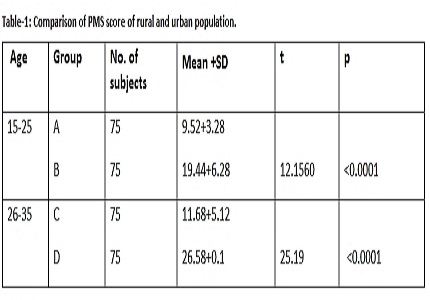To compare the severity of the premenstrual syndrome in urban and rural population
Abstract
Introduction: The premenstrual syndrome causes considerable morbidity to women. It is a silent epidemic which needs attention to provide quality of life to urban and rural women.
Objective: To compare the severity of the premenstrual syndrome in urban and rural population n the age group of 15-35 years and to study the selected variables and the relationship to premenstrual syndrome.
Methods: The cross-sectional study was carried out in the department of obstetric and gynecology at Integral institute of medical sciences and research, Lucknow from January 2016 to July 2016 for the period of 6 months.300 women (150 each for rural and urban population) from the age group of 15-35 years were given questionnaire (Modified Moos Menstrual Distress Questionnaire) and the results were compared using t and p value. The relationship of the variables like age, education, parity, socioeconomic status, education of the subjects mother, characteristic features of the menstrual cycle were assessed.
Result: The severity of premenstrual syndrome is more in urban population than rural population. The severity of PMS was directly proportional to age, parity, educational status, socioeconomic status. The severity of dysmenorrhoea was proportional to severity of PMS.
Conclusion: PMS is more severe in urban population .The severity increases with age, parity, educational status, and socioeconomic status and dysmenorrhoea.
Downloads
References
2. Parveen Marwah, Urvashi Gandi, Harpreet Kaur.Assessment and comparison of the premenstrual syndrome in urban and rural population.Asian Journal of OBS & Gyn Practice.2007;Vol 11, No.3, July-Sep,pg 7-11.
3. Dickerson LM, Mazyck PJ, Hunter MH. Premenstrual syndrome. Am Fam Physician. 2003 Apr 15;67(8):1743-52. [PubMed]
4. C.Ross,G.Coleman,C.Stojanovska. Personality and psychological factors affecting Premenstrual Syndrome.Journal of Psychosomatic Obstetric and Gynaecology.2003;vol24,Issue3,163-174.
5. Marván ML, Díaz Eroza MC. Premenstrual symptomatology in rural and urban zones. Acta Psiquiatr Psicol Am Lat. 1995 Dec;41(4):316-21. [PubMed]
6. Fontana AM and Badawy S.Perceptual and coping processes across the menstrual cycle: An investigation in a premenstrual syndrome clinic and community sample. Behav.Med.1997:22(4)152-159.
7. Marván ML, Díaz-Erosa M, Montesinos A. Premenstrual symptoms in Mexican women with different educational levels. J Psychol. 1998 Sep;132(5):517-26.
8. Woods NF, Most A, Longenecker GD. Major life events, daily stressors, and perimenstrual symptoms. Nurs Res. 1985 Sep-Oct;34(5):263-7. [PubMed]
9. Clare AW. Psychaitric and social aspects of premenstrual complaint. Psychol Med., Monograph (suppl 4)Cambridge University press 1983. [PubMed]
10. Budoff PW. Zomepirac sodium in the treatment of primary dysmenorrhea syndrome. N Engl J Med. 1982 Sep 16;307(12):714-9. [PubMed]

Copyright (c) 2016 Author (s). Published by Siddharth Health Research and Social Welfare Society

This work is licensed under a Creative Commons Attribution 4.0 International License.


 OAI - Open Archives Initiative
OAI - Open Archives Initiative



















 Therapoid
Therapoid

